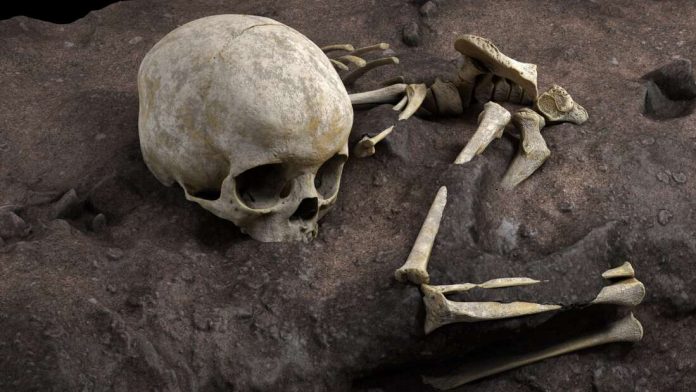A cave in Kenya has now been identified as the oldest intentional human burial site in Africa, with luminescence dating showing that the burial took place around 78,300 years ago. Excavation of the Panga ya Saidi cave, located to the north of Mombasa, revealed a grave located under a sheltered overhang, 3 meters (9.8 feet) deep below the present-day cave floor. The discovery was reported in a paper published today in the journal Nature.
“As soon as we first visited Panga ya Saidi, we knew that it was special,” said Professor Nicole Boivin, principal investigator of the original project, in a statement. “The site is truly one of a kind.”
The body in the grave was placed on their right side, with their legs drawn up to their chest. Analysis of the teeth revealed that the body was that of a child between 2.5 and 3 years old, who has now been nicknamed Mtoto – meaning “child” in Swahili.
“We started uncovering parts of the skull and face, with the intact articulation of the mandible and some unerupted teeth in place,” said Professor María Martinón-Torres, director at the National Research Center on Human Evolution (CENIEH) in Spain, where analysis of the remains took place. “The articulation of the spine and the ribs was also astonishingly preserved, even conserving the curvature of the thorax cage, suggesting that it was an undisturbed burial and that the decomposition of the body took place right in the pit where the bones were found.”
The bones in the grave were first uncovered in 2013, with the whole grave fully revealed in 2017. The pit appeared to have been deliberately dug, with the body quickly covered by sediment from the floor of the cave after being placed in the grave, indicating it was intentional. The body seemed to have been wrapped in a shroud made of perishable material, with the position of the skull indicating that a similarly perishable pillow was placed under the head. Though there were no signs of gifts or offerings as seen in other more recent burials, the treatment of the deceased suggested that the burial involved a ritual that many members of the community participated in.
This is the earliest known deliberate funerary burial by modern humans in Africa. Assessment of the child’s skeleton and teeth showed that they were most likely Homo sapiens – however, they retained some archaic features in their teeth, linking them back to other ancient human ancestors.
“The Panga ya Saidi burial shows that inhumation of the dead is a cultural practice shared by Homo sapiens and Neanderthals,” said study author Professor Michael Petraglia of the Max Planck Institute. “This find opens up questions about the origin and evolution of mortuary practices between two closely related human species, and the degree to which our behaviours and emotions differ from one another.”





























